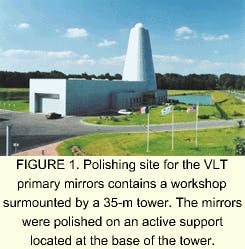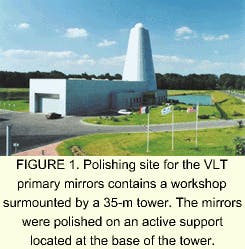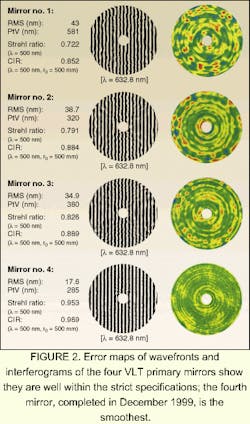Ten years have passed since REOSC (Saint Pierre-du-Perray, France) was selected by the European Southern Observatory (ESO) to polish four 8.2-m mirrors intended for the Very Large Telescope (VLT) at Cerro Paranal, Chile; REOSC is now a subsidiary of the SAGEM Group (Paris, France).
In addition to constructing the polishing building, the contract included fabricating one false concrete mirror for test and qualification and transporting the blanks from Schott Glaswerke (Mayence, Germany) to REOSC.
The optical polishing and testing plant was built during the first three years of the project (see Fig. 1). Concurrently, the equipment for mirror handling and transport, prepolishing and polishing, and measurement were installed. From 1993 to 1999 the four primary VLT mirrors were polished, along with two primary mirrors for the American Gemini telescope.
The telescopes of the previous generation used thick, rigid mirrors to minimize deformation caused by gravity. A VLT mirror constructed on this principle would be 1 m thick and weigh 100 tons, leading to a total telescope weight of 2200 tons?which is unrealistically heavy. Now, active optics technology allows the use of thin flexible mirrors. A wavefront sensor measures the mirror defects at regular time intervals and allows each of 150 axial actuators of the mirror support to correct the deformations and so retain an optimal optic quality. The mirror form is typically measured two to three times a minute, and the active support is adjusted with an accuracy of roughly 1 gram.
The meniscus is 175 mm thick (2% of the diameter of the primary VLT mirror), has a 1-m-diameter central hole, and weighs 24 tons. The entire telescope weighs only 430 tons.
Production and test
The blanks of the mirrors were made by a spin-casting process developed by Schott in 1986-1987. The Zerodur constituents were melted together in a large kiln producing 45 tons of liquid. After mixing, the Zerodur was cast in a spin mold at 1400°C and the mold rotation maintained during the first cooling stage (to 700°C) to obtain the desired concave meniscus form.
The Zerodur vitroceramic material was chosen because of its very low expansion coefficient, which eliminates surface deformations caused by temperature changes. This characteristic is decisive for producing a high-quality mirror because significant defects of the mirror optical surface are counted in nanometers, and a change in the mirror form of only 1 µm is very detrimental to image quality. The use of Zerodur also allows very low roughness.
The primary mirror consists of an optical combination of two mirrors: a primary concave mirror and a secondary convex mirror, a combination known as Ritchey-Chrétien after inventors Henri Chrétien and Willis Ritchey. (Henri Chrétien founded REOSC in 1937 along with Charles Fabry). Chrétien demonstrated that image quality can be improved by a hyperbolic mirror form, which is why the VLT primary mirror contains a 6-m-diameter bulge with a maximum height of 0.3 mm. The radius of curvature of the mirror is 28,800 mm, and the useful surface has an 8000-mm outer diameter and 1120-mm inner diameter.
To obtain a correct curvature form, two elements must be taken into account: the deviation from the ideal surface and the surface roughness. After active optic correction, the deviation from the ideal surface for a VLT primary mirror does not exceed 25 nm; surface roughness is 2 nm (see Fig. 2). A precision of 8.5 nm was achieved over all the optical surface of the mirror form during the polishing process, producing an optical resolution (theoretical image sharpness) of 0.03 arc sec in the visible spectrum. This level of precision equates to a VLT mirror the size of Paris on which the average surface defect would be approximately 9 µm and thus not discernible to the unaided eye. Ignoring terrestrial atmospheric effects, this mirror can discriminate an object measuring only 15 cm at a distance of 1000 km.
In January, the third 8.2-m telescope, Melipal (or Southern Cross), achieved first light. For the first time three 8.2-m telescopes were observing in parallel, with a combined surface of nearly 160 m2. The fourth VLT telescope (named Yepun, or Sirius) will become operational later this year (see Laser Focus World, March 2000, p. 18).
According to REOSC, the new polishing and control techniques are directly applicable to the new generation of segmented mirrors being developed for astronomy and space observations. They are, in this sense, at the forefront of optical technology.
Roland Roux


